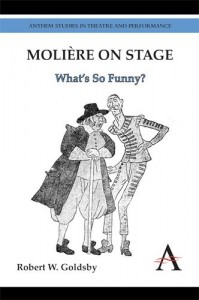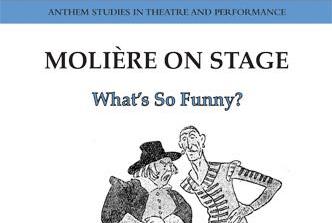 The simple title of Robert W. Goldsby’s new book, Molière on Stage: What’s So Funny?, belies an ambitious project—partly an examination of Molière’s life and work, and partly an examination of how and why his plays remain funny after nearly 350 years. While conventional wisdom tells us that explaining anything that’s meant to be funny is the quickest way to kill the humor, Goldsby has provided an invaluable service to Molière scholars, instructors, and practitioners alike.
The simple title of Robert W. Goldsby’s new book, Molière on Stage: What’s So Funny?, belies an ambitious project—partly an examination of Molière’s life and work, and partly an examination of how and why his plays remain funny after nearly 350 years. While conventional wisdom tells us that explaining anything that’s meant to be funny is the quickest way to kill the humor, Goldsby has provided an invaluable service to Molière scholars, instructors, and practitioners alike.
The tone of Goldsby’s erudite and entertaining book is rather like that of a favorite old history professor delivering a lecture on a beloved subject, weaving between history, personal anecdotes, and other material that might or might not be related (but the professor thinks it’s interesting), and then eventually getting back to his point. That’s not a criticism by any means. Goldsby, a combination scholar, director, translator and raconteur, not only displays a loving intimacy with his subject, but also almost convinces the reader that the author in fact spent a fair amount of time hanging out with Molière himself. In this way, Goldsby provides a happy marriage between scholarship and practice.
Goldsby divides his book into four acts, proceeding chronologically through Molière’s prodigious output of plays as well as significant points in the playwright/actor’s life, revealing a particularly tangled web of problems brought on both by himself and by the challenges of making a living as a theatre artist in 17th century France. While Molière was perhaps not quite wise enough to avoid making some unfortunate choices in the area of love (particularly in the matter of the young Armande, whom he raised as his daughter and subsequently married), he was wise enough to realize that his personal troubles would make excellent subjects for his comedies. Further fueling Molière’s offstage difficulties were his strained relations with the Church and the King, as well as the necessity to compartmentalize his marital and extra-marital relationships with his leading actresses (Goldsby is particularly adept at navigating this rough terrain). Thus, Molière creates and portrays the foolish husband Arnolphe in The School for Wives, a man who tries to sequester his young and inexperienced wife. Later, his battles with rumormongers and hypocrites in high places leads to Tartuffe, and his bitterness about the end of idealized love (relations with Armande were apparently chilly) leads to The Misanthrope. Goldsby makes these connections between real-life misadventures and onstage comedies and farces convincing and fascinating.
Perhaps of more value to the actor/director, Goldsby spends considerable time setting forth answers to his title question: what makes Molière funny, and how do you make him funny onstage? To answer these questions, Goldsby calls upon his generous experience as a director of such luminaries as Ron Leibman and Stacy Keach to give many pertinent examples of directors and actors bringing Molière’s iconic characters and stage moments to life. Further, he provides extensive linguistic analysis of both Moliere’s original French and the most lively and intelligent modern translations (including his own) to explain how the sounds of particular words amplify the humor. As one of Neil Simon’s characters once explained in The Sunshine Boys, certain words sound funny, a fact of audience response that Molière used to considerable advantage.
In the end, Goldsby has filled a significant need in Molière studies, and has done so in an accessible and entertaining manner. Fans as well as serious students of Molière now have a new and exciting resource, and actors and directors of the French comic master should reap great benefits as well.
Moliere on Stage: What’s So Funny?
by Robert W. Goldsby
New York: Anthem Press, 2012
202pp.
http://www.anthempress.com/


